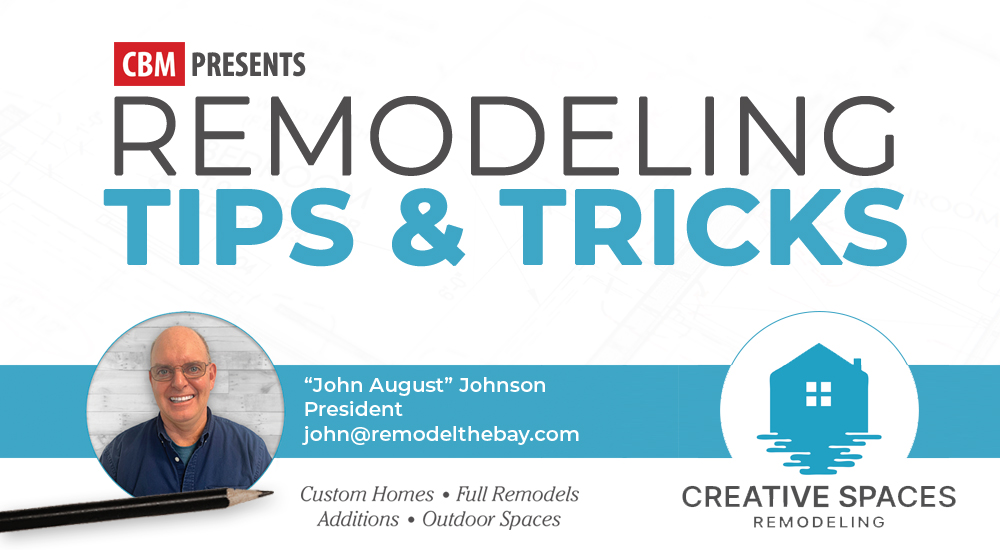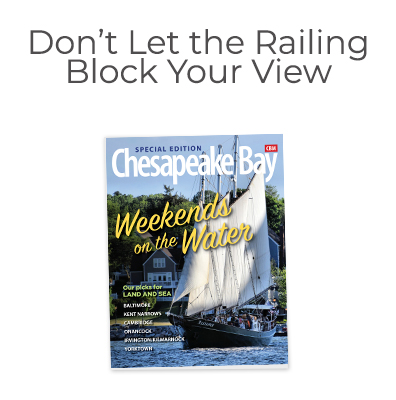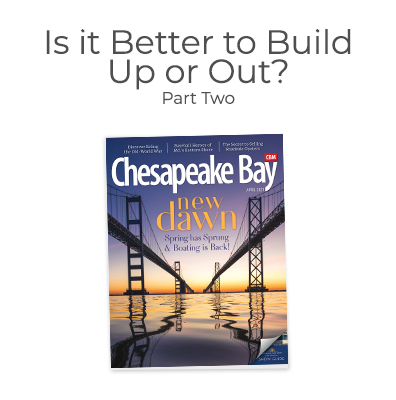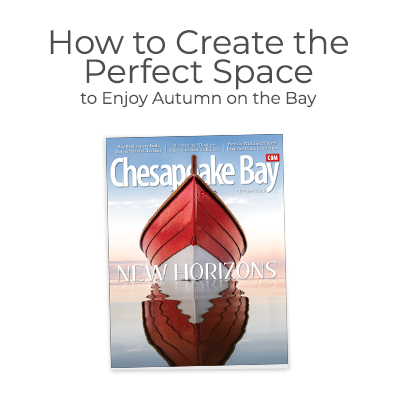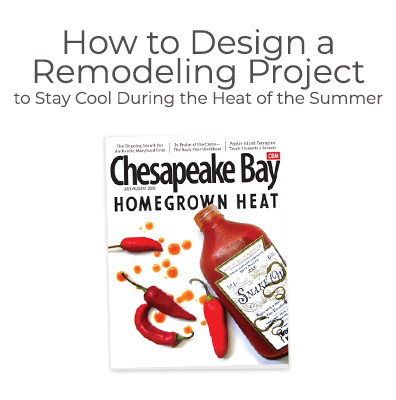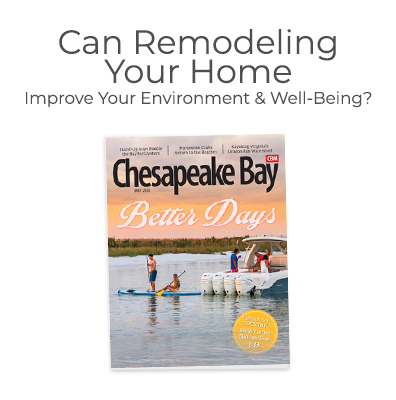“John August” Johnson of Creative Spaces Remodeling has been building and working closely with homeowners to achieve their dream home for more than 30 years and has been providing advice to CBM readers since 2020. Click below to learn some tips & tricks before tackling your home renovation projects and make sure you’re subscribed to Chesapeake Bay Magazine to get John’s latest articles every other month.
From Chesapeake Bay Magazine, December 2021
How Much Does it Cost?
How much does it cost to design and build a remodeling project? This is a great question that should be discussed at the very beginning of the process.
I have heard of far too many projects that started with a substantial financial investment for architectural drawings, but were never built because the construction costs exceeded the homeowner’s budget.
I have found that most everyone has some kind of budget in mind based on either their financial ability, the importance of the project, or the return on investment when they sell the home. All of these are important reasons for establishing a realistic budget. The hard part is that no one can really provide you the actual cost until you get your thoughts, desires and dreams on paper with architectural drawings. However, experienced Design/Build firms can take the time to fully understand your vision and provide you with a reasonable estimated cost before you spend any money on design. This is why we have a 3-step process that keeps our clients safe throughout the entire design phase. I personally feel that the budget needs to be a focal point and respected from the very first meeting to the completion of the project.
Designing smart ensures that you solve all your needs, gain all your desires, and can actually afford to finish your project.
Quick Tip:
With winter coming, make sure you clean your gutters from the fall leaves dropping. It’s much easier to clean them before the severe cold, ice and snow arrive.


From Chesapeake Bay Magazine, October 2021
It’s Boat Show Time
NEED A DOCK?
When replacing a dock or putting one in for the first time, there is a lot to think about. For starters, you will need the approval of the county and state, and also the Army Corps of Engineers.
How will you be using your dock? Will you need a boat lift, Jet Ski lift, and a guest slip, and how many of each? Will you be fishing and swimming from the dock or relaxing with friends? It’s important to make sure the electricity you have to your dock is sufficient for all the items you think you need plus a bit more. Many of my clients feel they don’t need dock lighting until a year later. They then also want a refrigerator for drinks and fish bait. Both are great ideas, just plan carefully, as running both electricity and water to your dock is an expensive part of the total costs. Yes, I mentioned water too, as you need to keep the new boat clean.
The design is obviously important as you need to figure out how to make everything fit. Regulations will tell you just how big your dock can be based on your location. The challenge is to fit everything you want into that size. One suggestion is to build your dock higher than you think you need. This has a great deal to do with your location and whether you are in a protected cove or exposed to severe weather and a lot of large boat wakes. Remember that you need to not only allow for regular tides but also extreme tides from hurricanes. Waves love to pound the decking boards, and can destroy a deck easily. Never underestimate the power of water. That’s just good advice from someone who has been on the water for about 50 years now.
Quick Tip:
There is an old saying when it comes to carpentry. “Measure twice and cut once”. When remodeling, building a custom home, or building a dock, Plan, plan, plan, and then build it once.
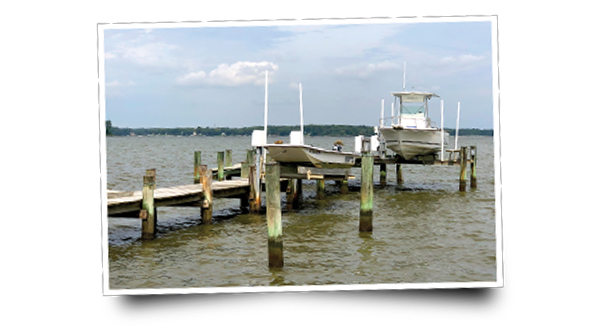

From Chesapeake Bay Magazine, August 2021
Don’t Let Your Railing Block Your View
When the view matters, choose wisely. Whether you’re building a deck, porch, or balcony, the railings you choose will have a drastic effect on the style, functionality, and feel of your home.
First, think about what it is that you want from your railing. Do you want it primarily for safety, making a design statement, blending into its surroundings, or all of the above?
Consider the space and how it will primarily be used. Will you be standing or seated? How about air flow? Is the space closed on two or three sides so a nice breeze will be welcome or do you want to create a bit of protection from the wind? Also think about maintenance. Do you have the time and budget for the upkeep of wood or do you prefer to pay a bit more upfront and have a relatively maintenance-free railing system? With that, we need to consider the budget. Yes, I know, the item that limits some of our choices but is a very important part of the decision making process.
There is a wide range of choices and price points for railings. The following are the most common in our area: wood, vinyl, composites, metal, cable, and glass. All of these come with several options. When deciding to add a railing to your home it’s important to do your own research or call an expert for help. Creative Spaces Remodeling will help you think your whole project through, slowly and carefully, to ensure your design and your product selections are exactly what you want.
Quick Tip:
I suggest to my clients to sit in the chair they want and have someone hold a 2 x 4 horizontally at the specified code height and/or different heights depending on your code options. You may find you can adjust the railing up or down slightly to make a difference on your view or choose a different chair height.

From Chesapeake Bay Magazine, June 2021
How to capture the best view possible when living on the waterfront?
Of course the first thing we think of is big windows and more big windows. However, there are subtle differences between all the window and door options that need to be carefully considered.
First, look at the make and the style of both windows and doors. How large do you really want to go, and will the framing affect the structural integrity of the wall? In regards to both windows and doors, you want to have as much glass as possible and eliminate items like sash bars, grids (also known as muntins) and mullions. We have learned through scientific research that the human eye will stop at objects like grids and such when looking out through a window. This eliminates the ability to truly appreciate the view beyond the glass. Some of our clients choose grids on the roadside for aesthetics and no grids on the waterside. Remember that you can get grids in many different patterns as well, which can drastically change the style of your home.
Large glass multi-folding and sliding doors are getting extremely popular as they are satisfying the desire to have a lot of glass and are very functional as well. Again, you want to keep the glass as clear and open from eye distractions as possible. We want to see the Ospreys!
The pros and cons of all the different types of glass exterior doors are vast. Think about what you want from your doors and the priority of those decisions. Examples could be the view, limited use, daily use, sliding, folding, kid-friendly or adult only, storage of the panels when opened, fixed panels, operating panels and when is shade needed and how will that factor in.
I feel taking the time to really think carefully about what you want and need from doors and windows before making the expensive purchase is worth the time.
Quick Tip:
Go to your own dock or a community pier and just take a moment to breathe deep and take in the beauty of nature. It’s absolutely amazing when you are quiet and let nature surround you. It’s also the least expensive therapy you can get as we continue to climb out of 2020.

From Chesapeake Bay Magazine, April 2021
Is it better to build up or out?
PART TWO
If you live further inland, your guidelines are not as restrictive. However, each county, and sometimes developments, can have different building setback restrictions. They are typically separated by front of home, rear of home, and sides of home. This is your starting point for considering building out.
Building an additional level on your home is considered a “pop-up.” This option is often the most desired as it removes all the concerns with building restriction lines and impervious surfaces. However, there could be restrictions regarding obstructing the views of others. A pop-up also adds some incredible living spaces with dramatic views, especially on the waterfront. This also provides a better return on investment, because the better the views, the more your property is worth. This option tends to be a bit more expensive, but provides a greater return.
When designing a pop-up, we must create a location for the staircase, which affects your existing lower level. It’s important to carefully prioritize all of your desired living spaces so you can decide what rooms and spaces you want on the upper and lower levels. We find many of our clients like to add balconies and roof top decks to embrace their improved views.
The other major item to consider is protecting your existing spaces on the lower level during the process of removing your existing roof and exposing your home to the weather while building the additional level and the new roof. This process is very complex and would not fit in this article. If you are considering adding an addition to your home either out or up, hire someone you can trust, with experience doing these types of projects.
Quick Tip: Now that spring is here, power-wash your home and clean your windows both inside and outside and don’t forget those screens. You’ll be amazed at how much more open and bright your home will feel.

From Chesapeake Bay Magazine, February 2021
Is it better to build up or out?
PART ONE
As our homes are becoming more important to us and we need more space, how do you decide if it’s better to build an addition out or add an additional level on top of your existing home?
The answer is not always a simple one.
Of course, my suggestion is to contact a design/build remodeler who specializes in these types of projects. However, here is a list of a few basic things to consider.
First, do you live on the waterfront? If so, then you should carefully understand and respect the Critical Area guidelines in your county and state, and if in Maryland, the 100-foot set-back guidelines. Within the critical area there are pervious and impervious surfaces which have additional guidelines that are strictly enforced with many requirements and restrictions to follow. The 100’ setback means that there is no permissible building within the first 100’ of the Critical Areas. The pervious and impervious guidelines are all about watershed. Basically speaking, your roof is impervious as it will not absorb water. However, your lawn is pervious which helps with cleaning and watershed before it drains into the Chesapeake Bay. An example of this concern is that the particles which also include chemicals will wash off the roof, into the gutters, down the downspouts and out. So, if there are not enough grass type areas to clean the water, it will all drain into the bay.
Stay tuned for more on this in CBM’s April issue – we’ve only scratched the surface on this topic!
Quick Tip: Now that many people are taking on their own DIY projects, remember that safety is always priority #1. If you are using a power tool you must remember to unplug it if you happen to step away for a break or quick phone call, as young children love to imitate you and will want to use the tools just like they saw you.

From Chesapeake Bay Magazine, November/December 2020
Has your home increased in value?
You might be thinking I am referring to monetary value. And maybe your home has increased in monetary value. However, I am referring to the growing desire for an improved lifestyle at home.
With the pandemic, we all have been forced to stay at home, work from home and go to school at home. We have also been trying our best to find ways to safely socialize with friends and family while maintaining a safe distance. Wow, what a year.
My clients have come to us with a major increased personal value placed on their home and want to improve its functionality and livability. Now that the home has so much more purpose in so many different ways, new designs and spaces with different purposes are necessary. Homeowners have new needs now based on working and school that can require proper desk space, office equipment and possibly sound proofing to family time, socializing with friends and personal quiet time. We are commonly asked to “create the feel and luxury of my last vacation get-away destination”. My clients want their home to be a place of happiness, relaxation and peace that they are always anxious to come home too.
If this feeling is familiar, start writing your thoughts down and discuss with your family what is truly important to you. Then put the items you come up with in priority order. You are now ready to start the transformation. I don’t see this changing anytime soon; rather I see it continuing to increase in importance over the years. Also remember with good, smart design, not only will your livability increase in value, but done correctly, your monetary value can increase as well.
Quick Tip: If you enjoy hanging holiday lights and such, BE SAFE. Always make sure your ladder is set with the proper angle and someone is at the bottom of the ladder spotting you for safety.

From Chesapeake Bay Magazine, September 2020
How to create the perfect space to enjoy Autumn on the Bay
As fall approaches, don’t miss out on enjoying your home’s outdoor living space and the beauty of our Chesapeake Bay.
Even as the temperatures begin to drop, it’s possible to continue enjoying all that nature provides. The key is to create spaces that have multiple functions and offer different opportunities throughout the year. This can be a challenge here in Maryland and Virginia, with our drastic temperature swings from season to season, but with some creativity and a bit of flexibility, it can be done.
With the advancement of extra-large sliding, folding, and hidden doors and windows, the ability to change quickly and easily from an indoor environment to an outdoor one is simple. I suggest creating a family room or great room that can be warm and cozy during the cold winter months, but opens up easily to another large space like a covered porch or pavilion. You want to seamlessly connect one to the other in both function, design, and feel. Your outdoor area can be equipped with gas or electric heat sources for winter and large fans for warmer weather. Along with controlling the temperature, you may want amenities such as large screen TV, comfortable furniture that can withstand the harsh elements, stereo system, fire pit, refrigerator, dining space, or even a game area. When you feel that first autumn nip in the air, you can prevent cabin fever and look forward to enjoying the beauty of the outdoors all year long from the comfort of your home.
It’s all about asking yourself, “What do I want and when do I want to do it?” Then let your design professional start creating the most favorite space in your home.
I hope you enjoy September and October as much as my wife and I do. It’s such a beautiful time on the Bay, as the temps start to fall but the water stays warm for a bit longer.
Quick Tip: Make sure you have your gutters cleaned soon if you haven’t done so. Preferably when most of the leaves have fallen, but definitely before the winter storms (rain or snow) begin.

From Chesapeake Bay Magazine, July 2020
How to design a remodeling project to stay cool during the heat of the summer
Summer is a wonderful time to be outdoors and enjoying nature, but brings with it some challenges, such as heat, humidity, bugs, sunburns, and more.
It’s important to start by asking yourself what you enjoy doing outdoors and when? Let’s start with the “what” question first. Is it relaxing, cooking, entertaining, sports, fishing, reading or enjoying an evening fire? Now ask yourself “when” do you want to enjoy your new outdoor space; spring, summer, fall, winter or all year? Let’s make a list and prioritize each item.
Is it early morning fishing or kayaking? Maybe the afternoon cornhole game and socializing into the evening with food, drink and a firepit? Will you need a screened area to keep bugs out and flies off your summertime food? Will you need some areas in the sun and some in the shade? Where is the sun during the time you will be enjoying the special space? If the focus is evening, what kind of lighting do you need to create the mood and feel you desire? How about a pool to cool down during a hot day and maybe a hot tub to relax in after all the water sports?
The key point I am trying to make is to really think everything through down to the small details. Success will come from this and careful planning. I suggest selecting a professional remodeler who also has design services and the experience to help you consider everything and bring up ideas you may not have considered. I suggest taking the time with your chosen remodeler and carefully work through your wish list and then, carefully figure out all the pros, cons, and budgets of each item.
My clients so often tell me that they want the relaxing and fun feel of their last vacation resort to be incorporated into their home, so what they experienced on vacation is present every day of their life.

From Chesapeake Bay Magazine, May 2020
Can remodeling your home improve your environment and well-being?
The answer is a resounding yes.
It’s been widely accepted that water can help alleviate some of the most common stressors such as mental fatigue, memory problems, anxiety and depression to mention just a few. When these feelings build, it can create stress overload and chronic stress. Many find the solution to be adding water features to their homes. You just happen to have the Chesapeake Bay which is one of the most beautiful water features right outside your window.
When living directly on the water’s edge, you can design both your indoor and outdoor living spaces around the water. I suggest creating a carefully designed personal interior space with incredible water views, all while staying inside during foul weather or increased pollen season. I also suggest creating relaxing outdoor living spaces by bringing nature directly to you or you to nature with not only the incredible waters views, but also aquatic sounds and smells. You can do this with features such as balconies, rooftop decks, patios, walkways, outdoor kitchens, screened porches, stone fireplaces with built-in pizza ovens and BBQ grills. For large gatherings think about covered pavilions with comfortable seating, open bar area and or course bathrooms. Whether you need a personal space to find some peace of mind and relaxation or you want to share your space and your therapeutic water with friends and family, it can be done.
If you are like me and get a sense of peace whenever you take that moment and just soak up nature’s beautiful Chesapeake Bay, you can make it a part of your everyday life if you choose. Embrace the water into your family’s lifestyle with smart design and both creative and intelligent building practices.
Let the healing begin.

From Chesapeake Bay Magazine, March 2020
Are remodeling and building different on waterfront properties than inland properties?
The answer is yes and no.
Yes, as to the regulations, permits and actual construction practices and materials. But not in the way we think and plan design.
With regard to the regulations, permits and construction, there are many restrictions when it comes to waterfront properties and how they will affect our Chesapeake Bay. Items to be aware of are established wetlands, land disturbance, containing soil runoff, first floor elevations due to flooding, and rising sea levels.
When building on the waterfront it’s important to select the correct materials that can withstand the harsh weather elements, especially during a major storm like a hurricane or nor’easter. Due to the salt content, stainless steel screws and nails are used. I also suggest insulation higher than regulations require, especially facing the water, as well as higher wind rated roofing shingles. It’s subtle, but the weather can be relentless on the waterfront even on beautiful days.
Each county can be different but all have property line setbacks from the water for new structures. Hire a professional that specializes in building on the water who knows all of the regulations before starting to design.
When designing, we use the same process whether on the water or inland. However, instead of focusing on a view of a green valley or a scenic mountain, it’s all about the water view.
The important part is to carefully review not only what you want to design, but why. Why do you want the kitchen off of the family room? Why do you want a place for the kids to hang their book bags? Reviewing the “why is something important” will help you prioritize the desired improvement. I suggest a “must have” list and a “nice to have” list. Then as you start the process of designing your new home or renovation, you have a clear direction of what you want, why you want it, and how it will improve your lifestyle and family living.


